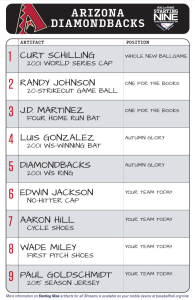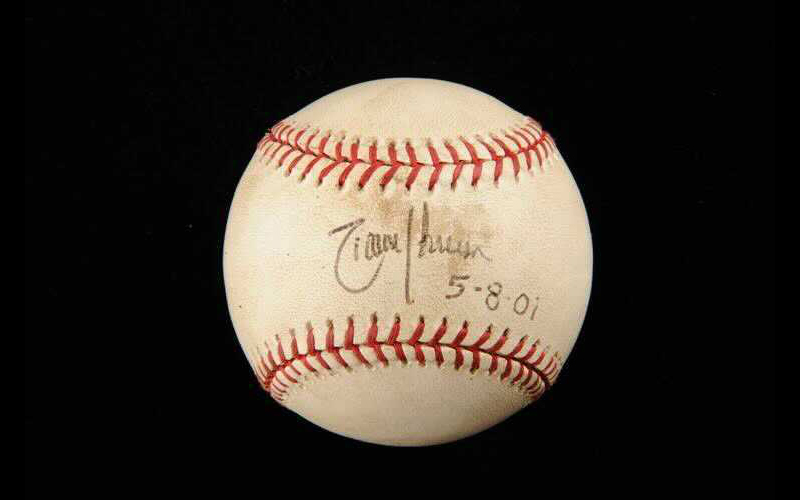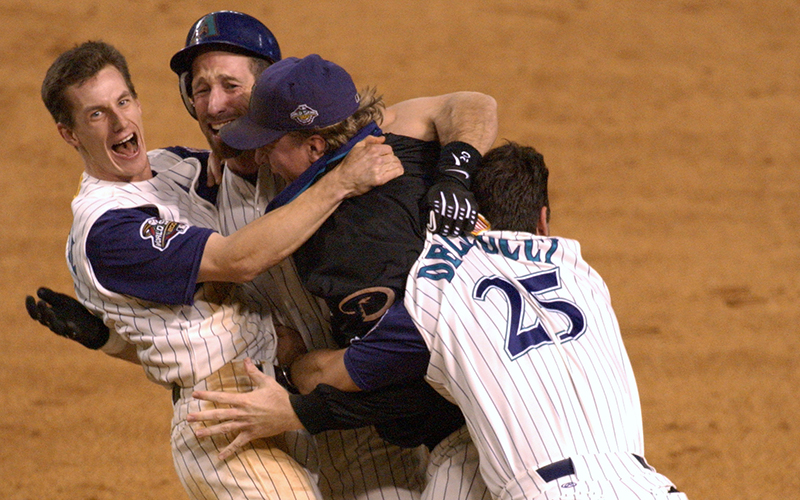PHOENIX – Tucked between the Adirondacks and the Catskills in Central New York lies a sleepy one-stoplight town, home to baseball giants of the past, present and future. While the quaint village of Cooperstown is known for its historical appeal, a new exhibit at the National Baseball Hall of Fame and Museum brings an innovative spin to the 85-year-old museum.
Tailored to the team of your choice, the new experience entitled “Starting Nine” boasts nine hand-picked pieces from each of the 30 MLB teams scattered around the hall. For Arizona Diamondbacks fans, this means special artifacts such as Luis Gonzalez’s 2001 World Series winning bat. Although a list of all teams “Starting Nine” artifacts can be found on the Hall’s forward-facing website, Baseball Hall of Fame President Josh Rawitch, a long-time Diamondbacks executive, said that the delicate balance of marrying technology with the actual touch and feel of being in a museum enhances the customized experience.

The bat Gonzalez used for the game-winning hit in the 2001 World Series is one of nine hand-picked pieces in the “Starting Nine” exhibit. (Photo courtesy of Milo Stewart Jr./National Baseball Hall of Fame and Museum)
“I think ultimately when you have fans come here, you know that everybody’s coming from somewhere and that their favorite team is probably going to be what drives their baseball experience,” Rawitch said. “You want to be able to give somebody a list of nine of the most interesting artifacts we have. And what’s great about it is that they are not going to be all in one spot… The goal is to make sure that people can connect, no matter where they came from or where they are at.”
Picking the artifacts was no easy task for the Hall’s curators, who spent countless hours walking the exhibits, researching their assigned divisions and ultimately debating on their chosen items for a spot in the “Starting Nine.” The curators were committed to finding a mix of artifacts ranging from baseballs, bats and jerseys, to the more obscure – such as a pair of cleats – each with special significance to America’s pastime.
“One of the things that I specifically remember about the Diamondbacks was that we actually had two Randy Johnson items on the list,” said curator Gabrielle Augustine. “One was the 20-strikeout game ball, and then the other was his cap from the 2001 World Series. So, I did some digging and found we also had a Curt Schilling World Series cap. In this case we did a one-for-one switch with the caps because Curt’s is telling the same story – that they’re co-MVPs of this franchise’s first World Series.”
Upon purchasing a ticket to the museum guests can ask for a scorecard, each of which contains a starting lineup of “must see” items that are among the over 4,000 baseball relics available for the public to view – a minuscule amount from the almost 40,000 artifacts and three million documents the Hall holds.

Items included in the Diamondbacks “Starting Nine” scorecard are Paul Goldschmidt’s 2015 season jersey, the bat Gonzalez’s used to deliver the ninth-inning hit that won Game 7 and delivered the 2001 World Series victory, Aaron Hill’s “cycle shoes,” Edwin Jackson’s no-hitter cap, Randy Johnson’s 20-strikeout game ball, J.D. Martinez’s four-home-run bat, the cleats worn by Wade Miley when he threw the first pitch in a game in Sydney, Australia, Curt Schilling’s 2001 World Series cap and a Diamondbacks 2001 World Series ring.
While the number nine seems small in comparison to the vast amount on display, the scorecard serves as a “starting point” of varied cross-generational items meant to spark conversation and nurture the shared mystique and attraction of the game itself.
“That’s the wonderful thing about Cooperstown and in this museum, we’re seeing those cross-generational conversations taking place all of the time,” said Ken Meifert , the Hall’s vice president of sponsorship and development. “There was a reason we chose the words ‘starting nine’ and not ‘top nine.’ These are lists of nine super-cool things that we have for your team on display in the museum, and we chose them because we felt like they fit that criterion.”
The charm of Cooperstown is second only to the National Baseball Hall of Fame Museum, which remains a bucket list item for many baseball faithful. Through experiences like “Starting Nine,” the nonprofit museum hopes to continue to remain relevant in an ever-changing sports climate while continuing to nurture the spirit and history of America’s pastime.



